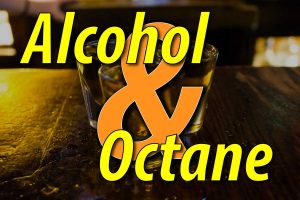
How Does Alcohol Content Effect Octane?
Alcohols such as methanol (methyl alcohol) and ethanol (ethyl alcohol) are commonly blended with high-performance fuels to achieve a higher octane rating. The concentration of these alcohols in fuel varies greatly, from just a splash to the primary part of the fuel. When you hear the term “racing alcohol”, that typically means pure methanol. Methanol is the fuel of choice for engines making extreme power. Ethanol, on the other hand, is what you find in E85 fuel, 85% ethanol and 15% something else combustible.
 There is a lot of debate over alcohol blended fuel octane ratings, but due to the limits of standardized testing equipment, you cannot measure the octane of alcohol. The ASTM (American Society for Testing and Materials) only allows the use of carburetors on Cooperative Fuel Research Engines (CFR). Of course, these aren’t standard carburetors. These carbs are designed to work within a specific set of parameters based on other fuel regulations. Because of these limited test parameters, these carbs can’t adjust enough to accommodate straight alcohol.
There is a lot of debate over alcohol blended fuel octane ratings, but due to the limits of standardized testing equipment, you cannot measure the octane of alcohol. The ASTM (American Society for Testing and Materials) only allows the use of carburetors on Cooperative Fuel Research Engines (CFR). Of course, these aren’t standard carburetors. These carbs are designed to work within a specific set of parameters based on other fuel regulations. Because of these limited test parameters, these carbs can’t adjust enough to accommodate straight alcohol.
So How Is Alcohol Octane Measured?
These limitations are where we start to see the Blended Octane Value (BOV). The BOV is determined when an alcohol blended gasoline is run through the CFR, followed by that same gasoline without its alcohol component. Some math is done to figure out how much effect the alcohol had on the base gasoline octane.
It’s important to note that the BOV number does not mean octane!
We’ve covered this a few times, but lets recap octane numbers to be safe. ASTM determines Octane numbers by averaging the RON (Research Octane Number) and MON (Motor Octane Number) values (R+M/2). This calculation is how we find the AKI (Anti Knock Index). In the United States, we see pump gas sold with an octane rating on the big yellow button. This number is AKI value.
Blended octane values commonly overestimate their octane rating due to diminishing returns. This problem means that some alcohol will increase the octane, but double that amount does not equal double the octane boost. In the purest sense, 2+2=3. So even though alcohol -blended fuel looks like it has a high octane rating, the actual value is not that high. And since the real numbers can’t be measured (see above), we have to guesstimate.
Related: What’s the point of blended synthetic oil?
Don’t Get Tricked By The BOV!
The best example of this is blended ethanol fuels. Ethanol alcohol’s BOV is around 112 octane. This value suggests that if you blend a small amount of ethanol into some gas, you will end up with an octane rating of 112. BUT, it’s not 112, it just appears that way when you add a little.
So when you see alcohol blended gasoline with a high octane number, do some research, because they may be trying to sell you the BOV, not the AKI!
If you have any questions or anything to add, please leave them in the comments or on our FaceBook page!
